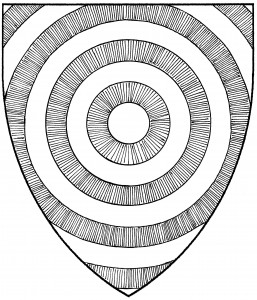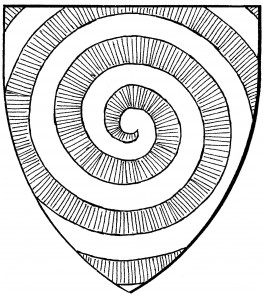Gurges: Difference between revisions
| Line 9: | Line 9: | ||
{| | {| | ||
| http://mistholme.com/wp-content/uploads/2014/01/gurges_ancient-257x300.jpg || http://mistholme.com/wp-content/uploads/2014/01/gurges_tudor-263x300.jpg | | http://mistholme.com/wp-content/uploads/2014/01/gurges_ancient-257x300.jpg || http://mistholme.com/wp-content/uploads/2014/01/gurges_tudor-263x300.jpg | ||
|- | |||
| Gurges, ancient || Gurges, Tudor | |||
|} | |} | ||
Revision as of 14:56, 4 July 2019
WARNING: Do not cite this page as a reference. This page is on this wikispace only to make the content "searchable" and easier to find. If you find the information you seek here, go to the original sources as linked below to verify the information and use them for your documentation.
Illustrations:
Period
Modern
Pictorial Dictionary of SCA Heraldry (3rd edition):
 |

|
| Gurges, ancient | Gurges, Tudor |
An Ordinary of Siebmacher's Wappenbuch
Modern:
Pictorial Dictionary, 3rd edition:
Vector Graphics:
Book of Traceable Heraldic Art
Annotated Pennsic Traceable Art Project
Sources:
- Academy of St. Gabriel "Medieval Heraldry Archive" - http://www.s-gabriel.org/heraldry/
- Archive of St. Gabriel reports - http://www.panix.com/~gabriel/public-bin/archive.cgi
- Laurel Armory Articles - http://heraldry.sca.org/laurel/armory_articles.html
- New Heraldic Primer (Heraldry for Non-Heralds) - http://heraldry.sca.org/armory/newprimer/
- Pictorial Dictionary of Heraldry (PicDic), 3rd Edition - http://mistholme.com/pictorial-dictionary-of-heraldry
- Period Armorials
- Parker's Heraldry - http://karlwilcox.com/parker/
- Riestap's Armorial Général - //http:www.euraldic.com/lasu/bl/bl_a_aa.html
Precedents:
Precedents of the SCA College of Arms - http://heraldry.sca.org/laurel/precedents.html
Morsulus Heralds Website - http://www.morsulus.org/ (to search the LoARs and Precedents)
Use the above links to be sure any precedents listed below haven't been superseded by newer precedents.
Definition:
(includes defaults, proper tinctures, blazoning)
July 1993 - gurges are a single, throughout charge
It has previously been ruled (LoAR of Oct 90) that the gurges may not be couped: "Whirlpools or gurges are used as a single, throughout charge on a field." July 1993 LoAR
Registerability:
(Restricted, Reserved, SFPP, OOP)
April 1992 - no gurges on fieldless badges
"Fieldless badges cannot use charges which issue or are defined by the edge of the field. The gurges is such a charge, and therefore may not be used on a fieldless badge." April 1992 LoAR
Conflict:
July 2005 - no difference for reversing gurges tinctures
"no difference will be granted between <tincture 1>, a gurges <tincture 2> and <tincture 2>, a gurges <tincture 1>."
===July 2005 Cover Letter: The question was raised this month about what difference is granted between a schnecke and a gurges. Current precedent, set by Da'ud Laurel, grants a CD between the two, but not substantial (X.2) difference:
- There is clearly a CD between a schnecke and a gurges, but the consensus of the commentary and those attending the meeting [was] that RfS X.2 does not apply between them. [Peter Schneck, 5/96]
Unlike the gurges, the schnecke seems to have started its heraldic life as a field division. Walter Leonhard's "Grosse Buch der Wappenkunst," 1984, p.165, classes the schnecke with other complex field divisions such as Schraegflammenspaltung (Per pale rayonny). Some of his schnecke-like field divisions are similar to period armory found in Siebmacher's "Wappenbuch of 1605": v. the arms of Fridesheim (plate 37), von Ellershofen (plate 106) and die Megentzer (plate 119). Leonhard blazons them all as divisions of the field, e.g. dreifacher Schneckenschnitt ("three-part Snail-cut"). But the schnecke itself he blazons as a charge: //linke geschuppte Schnecke// ("left-handed scaled Snail," which we'd blazon a schnecke invected reversed). This too is in Siebmacher, plate 198, as the arms of von Rordorf. This last example not only establishes the schnecke as a charge, but also lets us distinguish between the charge and the field: the invected line marks the charge. In SCA usage, the schnecke is always considered to be a charge.
The only thing the gurges and the schnecke have in common is a spiraling form. The schnecke never has more than a single revolution to its spiral: that is, if it issues from the chief, it circles the fess point of the shield once and comes to its point from chief. The gurges has at least four revolutions (if we take the concentric annular form as a baseline).
The research presented affirms the May 1996 precedent. Given their divergent evolutions and consistently differing emblazons, there is significant difference (a CD) between a gurges and a schnecke. However, there is not substantial (X.2) difference between the two.
Identifiability:
Collected Precedents:
- 2nd Tenure of Elisabeth de Rossignol (April 2011 - August 2011) - Collected Armory Precedents
- 1st Tenure of Elisabeth de Rossignol (May 2005 - July 2008) - GURGES and SCHNEKE
- 2nd Tenure of François la Flamme (October 2004 - May 2005) - Collected Armory Precedents
- The Tenure of Shauna of Carrick Point (May 2004 - August 2004) - Collected Armory Precedents
- 1st Tenure of François la Flamme (August 2001 - April 2004) - Collected Armory Precedents
- The Tenure of Elsbeth Anne Roth (June 1999 - July 2001) - Collected Armory Precedents
- The Tenure of Jaelle of Armida (June 1996 - June 1999) - Single HTML Document
- 2nd Tenure of Da'ud ibn Auda (November 1993 - June 1996) -
- The Tenure of Bruce Draconarius of Mistholme (June 1992 - October 1993) - Collected precedents
- 1st Tenure of Da'ud ibn Auda (June 1990 - June 1992) -
- The Tenure of Alisoun MacCoul of Elphane (September 1986 - June 1990) - Collected Precedents
- The Tenure of Baldwin of Erebor (August 1984 - August 1986) - Single HTML Document
- The Tenure of Wilhelm von Schlüssel (August 1979 - August 1984) - Collected Precedents
- The Tenure of Karina of the Far West (December 1975 - June 1979) - Collected Precedents
- The Early Days (June 1971 - June 1975) - Collected Precedents